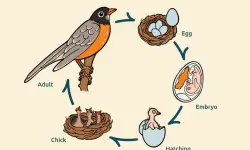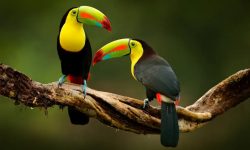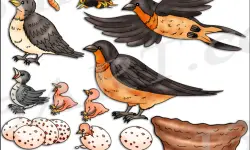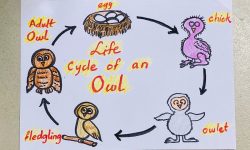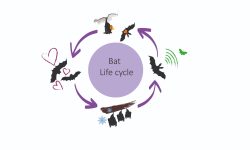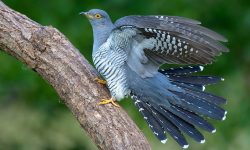Ducks are among the most recognizable and widespread waterfowl on Earth. Whether gliding on a quiet pond or migrating across continents, ducks exhibit a remarkable range of traits that make them both biologically intriguing and ecologically vital. In this article, we’ll explore 25 fascinating characteristics of ducks—from their unique anatomy to complex behaviors—that reveal the true brilliance of these aquatic birds.
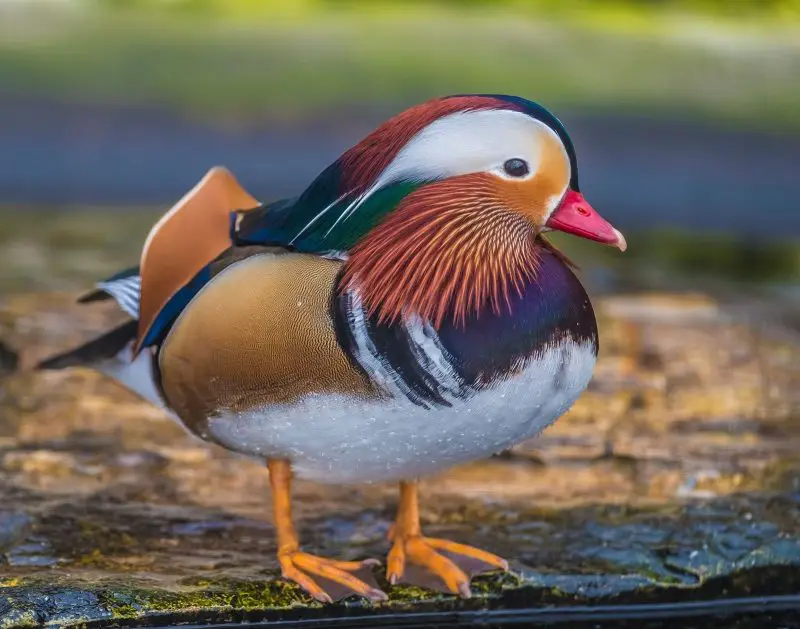
1. Flattened Bills with Filtering Structures
A duck’s bill is more than a feeding tool—it’s a fine-tuned filtration system shaped by evolution. Broad and flattened, the bill is lined with comb-like structures known as lamellae, which act as a biological sieve. These lamellae allow ducks to separate edible material like seeds, aquatic invertebrates, and tiny crustaceans from mud and water.
Dabbling ducks, such as mallards and teal, rely on this feature to sift through surface water or soft sediment in shallow wetlands. In contrast, diving ducks use more robust bills to seize slippery prey like small fish or snails from deeper waters. The structure of the bill, including its shape and sensitivity, is highly specialized depending on diet and foraging style—making the duck’s beak not just a characteristic feature, but a window into its ecological niche.
2. Waterproof Feathers
Ducks spend much of their lives in water, yet their feathers remain remarkably dry. This is no accident—it’s the result of a highly effective biological waterproofing system. Near the base of a duck’s tail lies the uropygial gland, a specialized organ that secretes an oily substance. Using their beaks, ducks meticulously preen and spread this oil across every feather.
But it’s not just oil that makes their feathers water-resistant. The feather structure itself, with tightly interlocking barbs and barbules, helps trap air and repel water. This combination of chemistry and microengineering creates a feather coat that insulates the duck, keeps it buoyant, and prevents hypothermia in cold water. Without this natural water-repellent system, a duck would quickly become waterlogged and lose the ability to swim or fly efficiently.
3. Webbed Feet for Swimming
Ducks don’t just wade through water—they glide, propelled by one of evolution’s most effective aquatic tools: webbed feet. These feet are structured like biological flippers, with three front-facing toes connected by a broad expanse of skin. When ducks push backward, the webbing spreads wide, maximizing surface area and thrust. During the forward stroke, the toes close like a fan to reduce drag.
This design allows for powerful propulsion and precise maneuvering, enabling ducks to chase prey, evade predators, and navigate fast-flowing currents. Even on land, their webbed feet assist with balance and mobility. The synergy between foot anatomy and muscle control turns every swim into a masterclass in fluid dynamics—a key reason ducks dominate both tranquil ponds and turbulent marshlands.
4. Light but Strong Skeleton
Flight is an energy-intensive activity, and every gram matters. Ducks, like most birds, have evolved a skeleton that strikes a balance between strength and weight. Their bones are pneumatic—meaning they’re hollow and filled with air sacs—reducing overall body mass without compromising durability.
This skeletal engineering is essential not only for flight but also for aquatic mobility. Their long, flat sternum anchors massive flight muscles, while strong vertebrae and fused collarbones add stability during takeoff and wing beats. Even the shape of their skull and beak contributes to streamlining. These structural adaptations allow ducks to launch into the air from water, sustain long migrations, and navigate both sky and stream with biomechanical finesse.
5. Camouflaged Plumage in Females
While male ducks often dazzle with iridescent blues, greens, and chestnut tones, female ducks are evolution’s masters of disguise. Their plumage typically consists of mottled browns, grays, and tans—colors that mirror the reeds, grasses, and muddy banks where they nest. This cryptic coloration isn’t just aesthetic; it’s a survival strategy.
During the nesting season, a female duck spends long periods motionless on her eggs. The subtle tones and broken patterns of her feathers make her nearly invisible to predators like foxes, raccoons, and hawks. Even her behavior complements the camouflage—staying still, choosing concealed nest sites, and sometimes performing distraction displays if a threat gets too close. This natural stealth suit gives ducklings a fighting chance before they’ve even hatched.
6. Sexual Dimorphism
One of the most visually striking characteristics of ducks is sexual dimorphism—the distinct difference in appearance between males and females of the same species. During the breeding season, male ducks, or drakes, undergo a dramatic transformation. Their plumage becomes a vivid palette of iridescent blues, greens, purples, and bold accent colors, designed not just to impress but to compete.
These bright feathers serve as visual signals in mate selection. Females are highly selective, often choosing mates based on symmetry, feather condition, and color intensity—indicators of genetic fitness. Meanwhile, female ducks retain more cryptic, earth-toned plumage year-round. Their muted colors enhance their camouflage while nesting, especially in environments filled with grass, reeds, or underbrush.
Outside the breeding season, many drakes molt into a duller, eclipse plumage, resembling females in color to reduce predation risk when they are flightless. This temporary seasonal disguise underscores how form and function in duck plumage are driven by both reproductive and survival pressures.
7. Seasonal Molting
Molting in ducks is more than a wardrobe change—it’s a finely tuned biological process vital to their survival. Each year, ducks shed and regrow their feathers in a process called molting. Typically, this happens once or twice annually, with timing varying by species and climate.
After the breeding season, male ducks enter what’s known as the “eclipse phase,” trading their bright, breeding plumage for a dull, female-like appearance. This camouflage helps protect them during a critical period when they are temporarily flightless. Unlike many birds that molt feathers gradually, ducks undergo a simultaneous wing molt, losing all their primary flight feathers at once.
This leaves them grounded for several weeks. During this vulnerable time, ducks rely on their wetland habitats for cover and food. Once their new feathers are fully developed, they regain flight and, in males, their vibrant colors. Molting is a metabolically demanding process, requiring protein-rich diets to support rapid feather regeneration. It’s a clear example of how physiology, behavior, and ecology converge in the life cycle of ducks.
8. Dabblers vs. Divers
Ducks aren’t a one-size-fits-all species when it comes to feeding. They fall into two main categories: dabblers and divers. Dabbling ducks, like mallards and northern pintails, forage in shallow water by tipping forward—tails up, heads submerged—skimming aquatic vegetation, insects, and small crustaceans from just below the surface. Their legs are positioned centrally on the body, which makes walking on land easier and helps with quick takeoffs from the water.
Diving ducks, on the other hand, are built for deep-water pursuits. Species like canvasbacks or scaups propel themselves underwater using powerful legs set farther back on their bodies. Their compact build and strong webbed feet let them plunge to depths where dabblers can’t reach, hunting for fish, mollusks, or submerged plants. These two feeding strategies are more than just style—they reflect anatomical and ecological specializations that allow ducks to exploit different habitats and reduce competition for food.
9. Wide Dietary Range
Ducks have evolved to be highly adaptable feeders, exhibiting one of the broadest dietary spectrums among birds. As omnivores, their menu includes aquatic vegetation, seeds, algae, insects, mollusks, crustaceans, and even small amphibians or fish. What they consume often depends on the species, season, and habitat.
Dabbling ducks primarily forage at or near the surface, skimming duckweed and submerged plants or sifting through mud for insects and seeds. Diving ducks, in contrast, plunge beneath the surface to hunt for snails, mussels, or aquatic arthropods. Some ducks even graze on land, targeting grains or crops in agricultural areas.
This dietary flexibility allows ducks to survive in diverse environments—from freshwater lakes and estuaries to rice paddies and salt marshes. It also supports their migratory lifestyle, enabling them to quickly exploit whatever food sources are available along their routes or in their seasonal habitats.
10. Global Distribution
Few bird families are as geographically widespread as ducks. Found on every continent except Antarctica, ducks have colonized an astonishing variety of habitats—from Arctic tundra to tropical wetlands, from freshwater lakes and rivers to coastal estuaries and urban parks. Their ability to adapt both physiologically and behaviorally has allowed them to thrive in environments ranging from saline marshes to man-made reservoirs.
Migratory species often span hemispheres, traveling thousands of miles between breeding and wintering grounds. Some species, like the Northern Pintail, may breed in Siberia and winter in South Asia or Africa. Resident ducks, such as those found in equatorial zones, often remain in one region year-round but still shift locally in response to seasonal rainfall or food availability.
This global spread isn’t just a testament to duck resilience—it reflects their ecological versatility and their integral roles in wetland systems across the planet.
11. Migratory Instincts
Migration is a marvel of endurance and navigation, and ducks are among the avian champions of this phenomenon. Many duck species, including northern pintails and blue-winged teal, travel thousands of miles between breeding grounds in the north and wintering areas in the south. These migrations require more than strong wings—they demand precise orientation and timing.
Ducks rely on an internal compass that integrates multiple navigational cues. They use celestial navigation, reading the position of the sun and stars, and detect Earth’s magnetic field through magnetoreceptors, possibly located in their beaks or eyes. Some species even recognize polarized light patterns, while others memorize visual landmarks during their first journeys.
Remarkably, young ducks often migrate without adult guidance, following genetically encoded routes. The timing of these migrations is triggered by hormonal changes in response to day length and temperature shifts. This combination of instinct, environmental awareness, and physiological readiness allows ducks to undertake epic seasonal journeys that span continents and connect ecosystems.
12. Imprinting Behavior in Chicks
Imprinting is one of the most captivating early-life phenomena in ducks. Shortly after hatching, ducklings form an intense and lasting attachment to the first moving object they see—usually their mother. This process occurs during a sensitive period, typically within hours of hatching, when their brains are highly receptive to learning social cues.
Through imprinting, ducklings not only recognize their mother’s appearance and vocalizations but also learn critical survival behaviors such as following, foraging, and predator avoidance. The bond is so strong that, in experimental settings, ducklings have been known to imprint on humans or even inanimate objects like rubber boots.
This instinctual behavior plays a vital role in group cohesion, enhancing the young birds’ chances of survival by ensuring they stay close to the protective and guiding presence of their parent. It’s a striking example of how early neural development shapes lifelong behavior in the animal kingdom.
13. Precocial Young
Ducks exhibit one of the most advanced forms of early development among birds. Their offspring are precocial—meaning that from the moment they hatch, they are already covered in downy feathers, have open eyes, and are capable of walking, swimming, and feeding themselves. This stands in stark contrast to altricial species, like songbirds, whose chicks hatch helpless, blind, and featherless.
This head start is made possible by a longer incubation period and greater yolk reserves in the egg, which allow duck embryos to complete much of their development before hatching. Within just a few hours of emerging from the egg, ducklings are mobile and ready to follow their mother into the water.
This independence doesn’t mean they’re entirely self-sufficient, though. They still rely on maternal guidance to learn where to forage, how to avoid predators, and when to seek shelter. The precocial strategy increases the odds of survival in open, wetland environments where staying in the nest could be more dangerous than staying on the move.
14. Cooperative Parenting
While the image of a mother duck leading her line of ducklings is iconic, parenting strategies in ducks are more diverse than they appear. In most species, the female indeed bears the primary responsibility for rearing the young—leading, protecting, and teaching her brood essential survival skills. However, in some duck species, especially those with social tendencies, cooperative parenting emerges as a powerful survival tool.
This cooperation can involve older siblings from previous broods, or even unrelated adults in communal nesting areas. These helpers may assist with vigilance against predators, guiding ducklings, or helping locate food. In highly dense breeding grounds, such behavior can increase the chances of survival for the entire clutch, reducing individual vulnerability and predator pressure.
This cooperative care blurs the line between instinct and social behavior, offering an intriguing window into avian group dynamics. It also underscores how flexible and adaptive duck reproductive strategies can be in response to environmental pressures.
15. Elaborate Courtship Displays
Duck courtship is a theatrical and carefully choreographed affair. Males of many species don’t just rely on their bright plumage to win over a mate—they put on a show. These displays often include synchronized head-bobbing, neck-stretching, tail-wagging, wing-flapping, and specialized vocalizations. Each movement and sound is finely tuned to attract the attention of a discerning female.
What’s remarkable is how species-specific these displays can be. For instance, the Wood Duck performs a ritualized dance with distinctive calls, while Northern Pintails use sharp whistle-like notes combined with upward neck thrusts. In some species, males gather in groups—known as leks—to compete for female attention through escalating performance routines.
These displays aren’t just for show; they communicate genetic fitness, health, and coordination. Females often choose mates based on the precision and vigor of these performances, ensuring that only the fittest males pass on their genes. Courtship in ducks is therefore a dynamic interplay of beauty, biology, and behavioral complexity.
16. Unique Vocalizations
The soundscape of the duck world is far more diverse than the iconic “quack” suggests. Ducks possess a rich vocal repertoire that varies by species, sex, and context. While mallards are known for their classic quacks—most commonly produced by females—other species have evolved a range of vocalizations, including high-pitched whistles, low grunts, raspy growls, and even mechanical-sounding squeaks.
These vocal signals serve a variety of purposes. During courtship, males often produce specialized calls to attract females, some of which are species-specific and synchronized with physical displays. Alarm calls warn others of nearby predators, while contact calls help keep flocks together in flight or while foraging.
Interestingly, some species, like the wood duck, rely heavily on vocal communication due to their woodland habitat, where visibility is limited. Ducklings also begin to vocalize soon after hatching, producing high-pitched peeps to stay connected with their mother and siblings. This acoustic diversity not only aids survival but also reflects the evolutionary pressures of life in varied and often noisy wetland environments.
17. Nest Site Selection
When it comes to nesting, ducks are incredibly versatile and strategic. Depending on the species, they may choose sites as diverse as grassy marshes, dense reeds, elevated tree cavities, or even open fields. This diversity in nest site selection is shaped by evolutionary pressures—especially the need to protect vulnerable eggs and ducklings from predators.
Ground-nesting species like mallards often seek concealed spots near water, where tall vegetation offers natural camouflage. Cavity-nesters, such as wood ducks and goldeneyes, take advantage of tree hollows or nest boxes, which offer additional security from ground-based threats. Some sea ducks even nest on remote cliffs or rocky islands, minimizing contact with land predators entirely.
Nest site selection also plays a role in temperature regulation, protection from flooding, and ease of access to food sources for both adults and ducklings. In some urban environments, ducks have been observed nesting on rooftops or balconies—testament to their adaptability and problem-solving capabilities. Regardless of location, the chosen site becomes a critical nursery where new generations begin their lives.
18. Egg Dumping
Among the more curious reproductive strategies in ducks is egg dumping, formally known as brood parasitism. In this behavior, a female duck lays one or more of her eggs in the nest of another female—often of the same species, though sometimes of a different one. The unsuspecting foster mother ends up incubating eggs that are not her own and may even raise the resulting ducklings.
This strategy allows the parasitic female to increase her reproductive output without the full cost of rearing more young. In high-density nesting areas, such as marshes or wetlands where nests are close together, egg dumping can be surprisingly common. In some species, like the redhead duck or ruddy duck, this behavior is not just occasional—it’s a prominent part of their reproductive strategy.
While this tactic benefits the parasitic female, it can strain the foster mother, especially if the added eggs push her clutch size beyond what she can manage. Still, in evolutionary terms, egg dumping represents a fascinating example of how reproductive tactics can vary widely, even within a single bird family.
19. Internal Navigation Systems
The migratory journeys of ducks stretch across continents and oceans, and yet these birds often return to the same exact wetlands, lakes, or estuaries year after year. How do they manage such navigational precision? The answer lies in a sophisticated internal guidance system that integrates multiple environmental cues.
Ducks rely on the position of the sun and stars to orient themselves during daylight and nighttime flights. More impressively, they can detect polarized light patterns—an optical phenomenon caused by sunlight scattering in the atmosphere—which allows them to gauge direction even under cloud cover. Perhaps most fascinating is their ability to sense Earth’s magnetic field. Specialized magnetoreceptors—likely located in their beaks or eyes—help them align their movements with the planet’s geomagnetic lines, functioning like a biological compass.
Studies suggest that this navigation system is partly learned and partly inherited. Juvenile ducks may imprint on visual landmarks during their first migrations, improving their precision in subsequent years. The combination of innate ability and environmental learning equips ducks with one of the most reliable natural navigation systems in the animal kingdom—a marvel of evolutionary engineering that continues to intrigue scientists today.
20. Monogamy in Some Species
In the avian world, ducks are often seen as seasonal romantics—forming new pair bonds each breeding season. However, some species challenge that stereotype by forming enduring monogamous relationships. Notable examples include the black-bellied whistling duck and the wood duck, both of which have been observed maintaining pair bonds across multiple seasons.
This form of social monogamy is more than sentimental. It provides functional advantages in breeding efficiency and territory defense. Long-term pairs tend to synchronize their reproductive efforts more effectively, often resulting in higher nest success. Familiarity between partners also reduces courtship time and helps coordinate incubation and chick-rearing tasks.
While true lifelong monogamy is rare, these repeat partnerships reflect an advanced level of behavioral sophistication in certain duck species. It underscores how even within a group known for flamboyant displays and shifting alliances, enduring bonds can emerge when they serve ecological and evolutionary goals.
21. Thermal Adaptations
Ducks often inhabit environments where water temperatures drop near freezing, yet they remain active, floating and foraging with ease. This ability comes down to a combination of anatomical and physiological thermal adaptations that help them conserve body heat.
One key mechanism is countercurrent heat exchange in their legs. Arteries carrying warm blood from the body core run adjacent to veins returning cooler blood from the feet. Heat is transferred between these vessels, warming the blood on its way back to the body and cooling the blood headed to the extremities. This reduces heat loss without restricting blood flow to the feet.
Additionally, ducks have a thick layer of down feathers beneath their waterproof outer plumage. These down feathers trap air close to the skin, acting as an insulating layer that prevents heat from escaping. When combined with behavioral strategies like tucking one leg under the body or huddling in groups, ducks can survive and thrive in some of the coldest aquatic environments on Earth.
22. Conservation Importance
Ducks play a crucial role as indicators of wetland ecosystem health. Because they depend heavily on aquatic habitats for food, breeding, and shelter, changes in duck populations often reflect the overall condition of these environments. Conservation efforts aimed at protecting ducks frequently lead to broader habitat preservation, benefiting countless other species—plants, fish, amphibians, and mammals alike.
Wetlands restored or maintained for ducks also provide vital services such as water purification, flood control, and carbon sequestration. By safeguarding duck habitats, we help maintain biodiversity and ecosystem resilience. Ducks serve as ambassadors for wetland conservation, reminding us of the interconnectedness of nature and the importance of preserving these fragile habitats for future generations.
23. Domestication and Agriculture
Ducks hold a significant place in human history as some of the earliest domesticated birds. Over thousands of years, humans have selectively bred ducks for various purposes including meat, eggs, feathers, and ornamental use. Domestic breeds such as the Pekin duck or Muscovy duck showcase a wide range of sizes, colors, and behaviors compared to their wild counterparts.
In agriculture, ducks are also valued as natural pest controllers. In rice paddies, for example, ducks forage on insects, snails, and weeds, reducing the need for chemical pesticides and helping to maintain ecological balance. Their droppings act as natural fertilizer, enhancing soil fertility and boosting crop yields.
This symbiotic relationship between ducks and humans highlights how domestication has not only shaped duck evolution but also contributed to sustainable farming practices around the world.
24. Role in Ecosystems
Ducks are vital contributors to aquatic ecosystems, playing multiple roles that help maintain ecological balance. Through their feeding habits, they control populations of insects, mollusks, and aquatic plants, preventing any one species from dominating and disrupting habitat stability.
As they forage and move through water, ducks stir up sediments, promoting nutrient cycling and oxygenation, which benefits fish and other aquatic organisms. Their droppings provide essential nutrients that fertilize aquatic plants, supporting food webs from the bottom up.
Moreover, ducks act as seed dispersers. Seeds caught in their feathers or ingested and later excreted can colonize new areas, aiding in wetland regeneration and plant diversity. Their presence often indicates a healthy, functioning ecosystem—one where water quality, vegetation, and animal life coexist in harmony.
25. Diverse Family Tree
The duck family, Anatidae, is impressively diverse, encompassing over 120 species worldwide. From the tiny teal, barely larger than a sparrow, to the massive eider, each species has evolved unique adaptations tailored to its environment. This diversity extends to variations in size, plumage coloration, vocalizations, behaviors, and habitat preferences.
Such richness allows ducks to thrive across an array of ecosystems—from Arctic tundras to tropical wetlands, freshwater lakes to coastal estuaries. Their evolutionary flexibility has made them one of the most dynamic bird families, with ongoing speciation and adaptation responding to changing climates and habitats.
Studying this family offers insights into evolutionary biology, ecology, and conservation, highlighting the complex interplay between genetics, environment, and survival strategies.
Conclusion
Ducks are far more than familiar figures at the local pond. Their complex biology, rich behaviors, and ecological importance make them key players in both natural and human-shaped environments. Whether you’re a birdwatcher, farmer, or nature enthusiast, understanding the remarkable traits of ducks deepens our appreciation for their role in the natural world.

